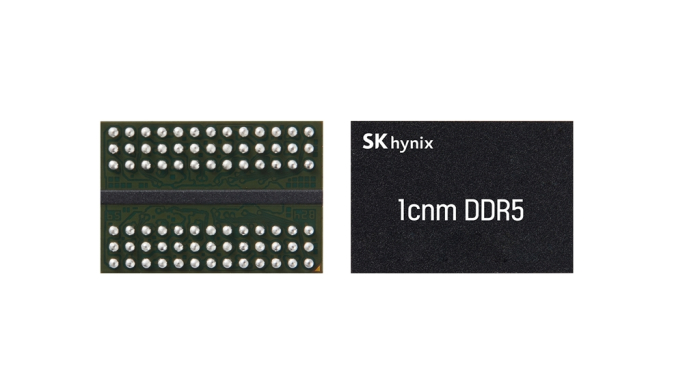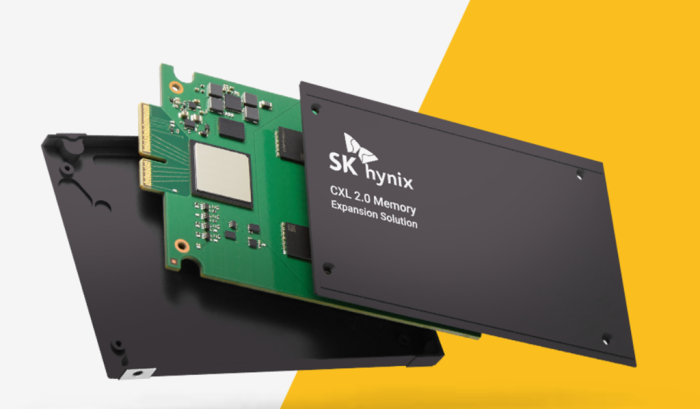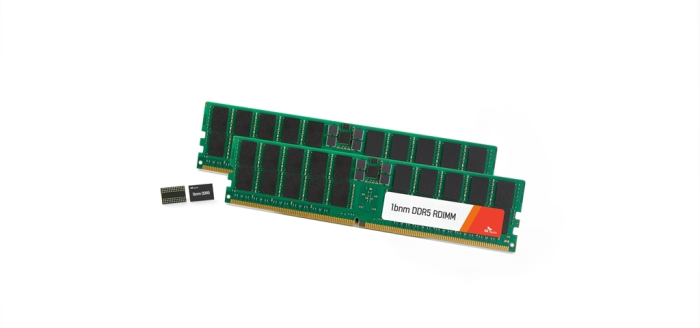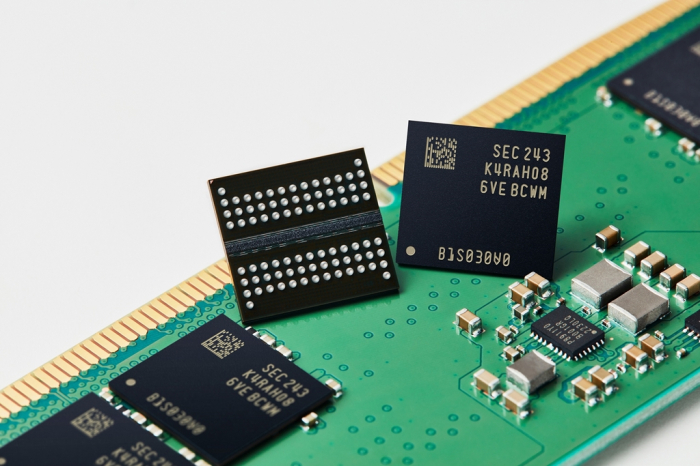SK Hynix unveils industry’s 1st 10-nanometer DDR5, aims for top spot
SK is ahead of rivals Samsung and Micron in unveiling the world’s finest chip process node for DDR5 chips
By Aug 29, 2024 (Gmt+09:00)
Samsung steps up AR race with advanced microdisplay for smart glasses


When in S. Korea, it’s a ritual: Foreigners make stops at CU, GS25, 7-Eleven


Maybe Happy Ending: A robot love story that rewrote Broadway playbook


NPS yet to schedule external manager selection; PE firms’ fundraising woes deepen


US auto parts tariffs take effect; Korea avoids heavy hit



SK Hynix Inc., the world’s second-largest memory chipmaker after Samsung Electronics Co., has emerged as the dominant player in the sought-after high-bandwidth memory (HBM) segment amid the AI boom.
The SK Group affiliate now also aims for the top spot in the overall DRAM market by advancing its chip processing technology faster than its rivals.
The South Korean chipmaker said on Thursday it has developed the industry’s first 16 gigabit (Gb) DDR5 built using its 1c node – the sixth generation of the 10-nanometer process technology.
SK Hynix is the first memory maker to announce the use of the 1c or 10 nm-class process technology to produce DDR5 DRAM, leaving rivals such as Samsung and Micron Technology Inc. technologically behind.
“The degree of difficulty to advance the shrinking process of the 10 nm-range DRAM technology has grown over tech generations, but we have become the industry’s first to overcome the technological limitations, following our industry-leading 1b technology, or the fifth-generation 10 nm node,” the company said in a statement.

SK Hynix said it will be ready for mass production of the 1c DDR5 by the end of this year to start volume shipments next year.
DDR5, NEW DRAM STANDARD
In May 2023, Samsung said it had begun mass production of 16 Gb DDR5 DRAM chips, using a 12-nanometer process node.
DDR5, short for double data rate 5, is the next-generation DRAM chip, boasting faster speed and higher density with reduced power consumption compared to previous DDR4 chips. The latest memory is suitable for data-intensive supercomputing, artificial intelligence and machine learning applications.
With exponential data growth, DDR5 is becoming the new standard in the DRAM segment.

Such chips are used for high-performance data centers as well as machine learning platforms that enhance the AI and super-computing performance level.
SK Hynix became the industry’s first chipmaker to release DDR5 DRAM in October 2020.
Last year, the company said it is using the 1b tech to mass-produce 64 gigabyte (GB) DDR 5 server DRAM following performance verification tests with Intel Corp.
IMPROVEMENTS
In the chipmaking process, nanometer refers to the circuitry size of the transistors that can be packed on a chip. The lower the nanometer number, the more advanced the technology, promising a faster computing speed, higher performance and lower power use.

SK Hynix’s latest 1c DDR5 using a 10 nm process node runs at the speed of 8 gigabits per second (Gbps), 14% faster than its previous model. Power consumption has improved by over 9%, it said.
SK Hynix said it expects the adoption of its 1c DDR5 DRAM to reduce data centers' electricity costs by up to 30%.
“We are committed to providing differentiated values to our customers by applying the 1c technology equipped with the best performance and cost competitiveness to our major next-generation products including HBM, LPDDR6 and GDDR7,” said Kim Jong-hwan, head of DRAM Development at SK. “We will work toward maintaining our leadership in the DRAM space and positioning as the most trusted AI memory solution provider.”
The company also plans to apply its 1c technology to manufacture HBM4E, the seventh-generation HBM chip, from 2026.
Write to Eui-Myung Park at uimyung@hankyung.com
In-Soo Nam edited this article.
-
 Korean chipmakersSK Hynix eyes DDR5 dominance with industry’s fastest chip modules
Korean chipmakersSK Hynix eyes DDR5 dominance with industry’s fastest chip modulesOct 25, 2022 (Gmt+09:00)
2 Min read -
 Korean chipmakersSK Hynix’s new LPDDR5T chip shipped to Vivo for X100 smartphones
Korean chipmakersSK Hynix’s new LPDDR5T chip shipped to Vivo for X100 smartphonesNov 13, 2023 (Gmt+09:00)
3 Min read -
 Korean chipmakersSK Hynix’s LPDDR5T chip likely mounted on MediaTek’s Dimensity
Korean chipmakersSK Hynix’s LPDDR5T chip likely mounted on MediaTek’s DimensityAug 10, 2023 (Gmt+09:00)
3 Min read -
 Korean chipmakersSK Hynix’s latest 1b nm DDR5 DRAM chip under Intel test run
Korean chipmakersSK Hynix’s latest 1b nm DDR5 DRAM chip under Intel test runMay 30, 2023 (Gmt+09:00)
2 Min read -
 Korean chipmakersSamsung rolls out industry’s finest 12 nm DDR5 DRAM chips
Korean chipmakersSamsung rolls out industry’s finest 12 nm DDR5 DRAM chipsMay 18, 2023 (Gmt+09:00)
3 Min read -
 Korean chipmakersMicron’s entry into DDR5 market: A boon for Samsung, SK Hynix
Korean chipmakersMicron’s entry into DDR5 market: A boon for Samsung, SK HynixAug 30, 2022 (Gmt+09:00)
2 Min read -
 Korean chipmakersSK Hynix makes industry’s highest density 24Gb DDR5 DRAM chip
Korean chipmakersSK Hynix makes industry’s highest density 24Gb DDR5 DRAM chipDec 15, 2021 (Gmt+09:00)
2 Min read


